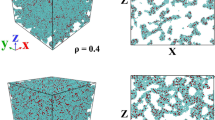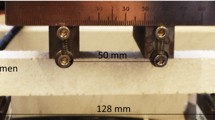Abstract
Porous glass with closed controlled porosity is used as a model system in order to numerically assess the effect of pores on the macroscopic mechanical and fracture behavior of brittle solids. A computational code called OOF, which converts digitalized two-dimensional (2-D) images of materials microstructures into finite element meshes, is adopted, so that the effect of 2-D microstructural features (e.g. pore size and shape) on the global mechanical response of the material can be determined. Firstly, microstructures of porous glass bodies containing isolated pores were considered. These specimens were numerically investigated in terms of fracture initiation and propagation: the numerical model predicted that larger pores initiate fracture, in agreement with experimental results. Then, the effect of porosity on the elastic and fracture properties was thoroughly investigated by means of model two-dimensional microstructures consisting of selected area fractions of pores (equivalent to pore volume fractions in three dimensions) and with prescribed pore shape, orientation and dimensions. In particular, the effect of pore dimension and shape was studied, finding that the critical stress for crack initiation scales with pore dimension and aspect ratio, i.e. oblate and larger pores oriented perpendicularly to the stress direction cause a higher reduction of strength of the specimen. Finally, several 2-D microstructures characterized by different values of area fraction of pores of the same shape were investigated, in order to determine the variation of elastic properties and the fracture response of porous glasses with pore content. The study confirms the suitability of the 2-D OOF code to investigate the mechanical and fracture behavior of porous materials. Issues regarding the limitation of the model due to its 2-D character are also discussed where appropriate.
Similar content being viewed by others
References
S.J. Penn, N. McAlford, A. Templeton, X. Wang, M. Xu, M. Reece, and K. Schrapel, Effect of porosity and grain size on the microwave dielectric properties of sintered alumina, J. Am. Ceram. Soc. 80, 1885 (1997).
H. Banno, Effects of shape and volume fraction of closed pores on dielectric, elastic and electromechanical properties of dielectric and piezoelectric ceramics. A theoretical approach, Ceram. Bull. 66, 1332 (1987).
J. Wu and L.C. De Jonghe, Alumina-coated hollow glass spheres/alumina composites, J. Mat. Sci. 32, 6075 (1997).
G. Liu and D.L. Wilcox Sr., Design guidelines and water extraction synthesis cababilities for hollow ceramic microspheres for low dielectric constant inorganic substrates, Mat. Res. Soc. Symp. Proc. 372, 231 (1995).
W.A. Yarbrough, T.R. Gururaja, and L.E. Cross, Materials for IC packaging with very low permittivity via colloidal sol-gel processing, Ceram. Bull. 66, 692 (1987).
J.K. Yamamoto, K. Kata, and Y. Shimada, Fabrication of controlled porosity in a tape cast glass ceramic substrate material, Mat. Lett. 8, 278 (1989).
R.W. Rice, Porosity of Ceramics (Marcel Dekker, 1998).
A.D.Vasilev and S.A. Firstov, Toughening by pores, in Advanced Multilayered and Fibre-Reinforced Composites, edited by Y.M. Haddad (Kluwer Academic Publishers, 1998), p. 371.
M. Arnold, A.R. Boccaccini, and G. Ondracek, Theoretical and experimental considerations on the thermal shock resistance of sintered glasses and ceramics using modeled microstructure-property correlations, J. Mat. Sci. 31, 463 (1996).
A.R. Boccaccini, Fabrication, microstructural characterization and mechanical properties of glass compacts containing controlled porosity of spheroidal shape, Journal of Porous Materials 6, 369 (1999).
A.R. Boccaccini, J.L. Spino, and V. Cannillo, Hermetic glass bodies with controlled porosity: Processing and properties, Ceram. Eng. Sci. Proc. 23(4), 191 (2002).
A.P. Roberts and E.J. Garboczi, Elastic properties of model porous ceramics, J. Am. Ceram. Soc. 83, 3041 (2000).
C.T. Herakovich and S.C. Baxter, Influence of pore geometry on the effective response of porous media, Journal of Materials Science 34, 1595 (1999).
T. Nakamura, G. Qian, and C.C. Berndt, Effects of pores on mechanical properties of plasma-sprayed ceramic coatings, J. Am. Ceram. Soc. 83, 578 (2000).
T. Nakamura and Z. Wang, Simulation of crack propagation in porous materials, Transaction of the ASME 68, 242 (2001).
I. Doltsinis and R. Dattke, Modeling the damage of porous ceramics under internal pressure, Comput. Methods Appl. Mech. Engrg. 191, 29 (2001).
K. Lee and S. Ghosh, A microstructure based numerical method for constitutive modeling of composite and porous materials, Materials Science and Engineering A 272, 120 (1999).
K. Lee and S. Ghosh, Small deformation multi-scale analysis of heterogeneous materials with the Voronoi cell finite element model and homogeneization theory, Computational Materials Science 7, 131 (1996).
W.C. Carter, S.A. Langer, and E.R. Fuller, The OOF manual: version 1.0, (http://www.ctcms.nist.gov/oof/), 1998.
C.H. Hsueh, E.R. Fuller, S.A. Langer, and W.C. Carter, Analytical and numerical analyses for two-dimensional stress transfer, Mater. Sci. Eng. A 268, 1 (1999).
C.H. Hsueh, J.A. Haynes, M.J. Lance, P.F. Becher, M.K. Ferber, E.R. Fuller, S.A. Langer, W.C. Carter, and W.R. Cannon, Effects of interface roughness on residual stresses in thermal barrier coatings, J. Am. Ceram. Soc. 82, 1073 (1999).
C.-H. Hsueh and E.R. Fuller Jr., Residual stresses in thermal barrier coatings: Effects of interface asperity curvature/height and oxide thickness, Materials Science and Engineering A 283, 46 (2000).
A. Zimmermann, E.R Fuller, and J. Rödel, Residual stress distributions in ceramics, J. Am. Ceram. Soc. 82, 3155 (1999).
A. Saigal, E.R. Fuller Jr., S.A. Langer, W.C. Carter, M.H. Zimmermann, and K.T. Faber, Effect of interface properties on microcracking of iron titanate, Scripta Materialia 38, 1449 (1998).
A. Saigal and E.R. Fuller Jr., Analysis of stresses in aluminum-silicon alloys, Computational Materials Science 21, 149 (2001).
V. Cannillo and W.C. Carter, Computation and simulation of reliability parameters and their variations in heterogeneous materials, Acta Materialia 48, 3593 (2000).
A. Zimmermann, D.M. Baskin, K.T. Faber, E.R. Fuller Jr., A.J. Allen, and D.T. Keane, Fracture of a textured anisotropic ceramic, Acta Materialia 49, 3231 (2001).
A. Zimmermann, W.C. Carter, and E.R Fuller, Damage evolution during microcracking of brittle solids, Acta Mater. 49, 127 (2001).
V.R. Vedula, S.J. Glass, D.M. Saylor, G.S. Rohrer, W.C. Carter, S.A. Langer, and E.R. Fuller, Residual-stress prediction in polycristalline alumina, J. Am. Ceram. Soc. 84(12), 2947 (2001).
V. Cannillo, C. Leonelli, and A.R. Boccaccini, Numerical models for thermal residual stresses in Al2O3 platelets/borosilicate glass matrix composites, Materials Science and Engineering A A323, 246 (2002).
V. Cannillo, A. Corradi, C. Leonelli, and A.R. Boccaccini, A simple approach for determining the “in-situ” fracture toughness of ceramic platelets used in composite materials by numerical simulations, Journal of Materials Science Letters 20, 1889 (2001).
V. Cannillo, G.C. Pellacani, C. Leonelli, and A.R. Boccaccini, Numerical modelling of the fracture behaviour of a glass matrix composite reinforced with alumina platelets, Composites Part A 34, 43 (2003).
M.F. Horstmeyer, M.M. Matalanis, A.M. Sieber, and M.L. Botos, Micromechanical finite element calculations of temperature and void configuration effects on void growth and coalescence, International Journal of Plasticity 16, 979 (2000).
V. Kouznetsova, W.A.M. Brekelmans, and F.P.T. Baaijens, An approach to micro-macro modeling, Computational Mechanics 27, 37 (2001).
T. Schneider, P. Greil, and G. Schober, Strength modeling of brittle materials with two-and three-dimensional pore structures, Computational Materials Science 16, 98 (1999).
A.R. Boccaccini, J. Bossert, M. Bücker, and E.E. Mombello, Berechnung der Bruchfestigkeit von porö senWerkstoffen unter Betrachtungen von Kerbspannungen, Materialwissenschaft u. Werkstofftechnik 28, 1 (1997).
A.R. Boccaccini, Influence of stress concentrations on the mechanical property-porosity correlation in porous materials, J. Mat. Sci. Lett. 17, 1273 (1998).
K.R. Janowsky and R.C. Rossi, Elastic behaviour if MgO matrix composites, J. Am. Ceram. Soc. 50, 599 (1967).
E.A. Dean, Elastic moduli of porous sintered materials as modeled by a variable aspect-ratio self consistent oblate spheroidal inclusion theory, J. Am. Ceram. Soc. 66, 847 (1983).
L.F. Nielsen, Elasticity and damping of porous materials and impregnated materials, J. Am. Ceram. Soc. 67, 93 (1983).
K.A. Snyder, E.J. Garboczi, and A.R. Day, The elastic-moduli of simple 2-dimensional isotropic composites—Computer-simulation and effective medium theory, J. Appl. Phys. 72(12), 5948 (1992).
A.R. Boccaccini, G. Ondracek, P. Mazilu, and D. Windelberg, On the effective Young's modulus of elasticity for porous materials: Microstructure modelling and comparison between calculated and experimental values, J. Mech. Behavior Mat. 4(2), 119 (1993).
E. Ryskewitch, Compression strength of porous alumina and zirconia—9th communication to ceramography, J. Am. Ceram. Soc. 36, 65 (1953).
Y. Inagaki, T. Ohji, and S. Kanzaki, Fracture energy of a aligned porous silicon nitride, J. Am. Ceram. Soc. 83, 1807 (2000).
L. Coronel, J.P. Jernot, and F. Osterstock, Microstructure, mechanical properties of sintered glass, J. Mat. Sci. 25, 4866 (1990).
J. Wang, L.J. Vandeperre, R.J. Stearn, and W.J. Clegg, The fracture energy of porous ceramics, Key Eng. Mat. 206-213, 2025 (2002).
J. Wang, L.J. Vandeperre, R.J. Stearn, and W.J. Clegg, Pores and cracking in ceramics, Journal of Ceramic Processing Research 2, 27 (2001).
Author information
Authors and Affiliations
Rights and permissions
About this article
Cite this article
Cannillo, V., Leonelli, C., Manfredini, T. et al. Computational Simulations for the Assessment of the Mechanical Properties of Glass with Controlled Porosity. Journal of Porous Materials 10, 189–200 (2003). https://doi.org/10.1023/A:1027490502044
Issue Date:
DOI: https://doi.org/10.1023/A:1027490502044




